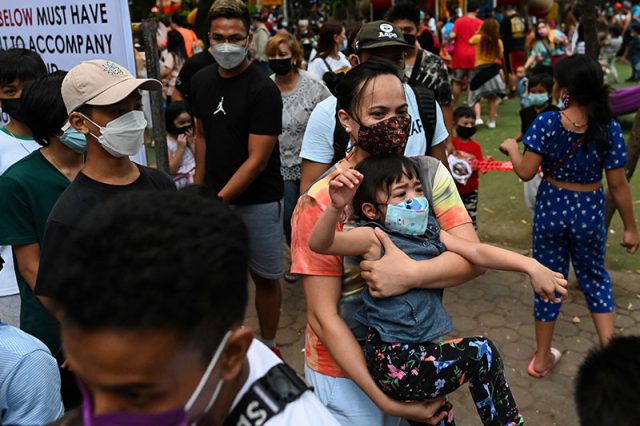
Concerned citizens called on fellow Filipinos to prevent abusing the “opportunities” from eased quarantine restrictions as the National Capital Region gets downgraded to Alert Level 2 of the general community quarantine.
The Inter-Agency Task Force for the Management of Emerging Infectious Diseases (IATF-EID) has approved the proposal to loosen quarantine restrictions in the country’s economic center.
Metro Manila was supposed to stay under Alert Level 3 until November 14.
Presidential adviser for entrepreneurship Joey Concepcion had called on the IATF to relax NCR’s status, citing the decrease in the number of COVID-19 infections last month.
Earlier this week, Trade Secretary Ramon Lopez also said that a downgrade to Alert Level 2 in two weeks was possible.
Under this alert level, indoor venues are allowed to accept a maximum of 50% venue capacity for fully vaccinated people and those below 18 years old, even if they are unvaccinated.
Outdoor venues, on the other hand, are allowed to accept up to 70 % of their capacity provided that all of their workers are fully vaccinated.
Intrazonal and interzonal travel are also allowed under Alert Level 2.
Gatherings in residences involving those not belonging to the same household are likewise allowed in this quarantine status.
Tourism chief Bernadette Romulo-Puyat thanked her colleagues in the IATF for hearing the plea of the stakeholders to put NCR under Alert Level 2. She said that it will provide greater mobility to the public, including children and seniors.
“The eased travel restrictions under this alert level will greatly help tourism businesses bounce back and maximize the opportunities brought by the holiday season,” Puyat said.
“We also expect more Filipinos–especially families with children and elderly–to be able to enjoy our tourist destinations while following minimum health and safety protocols,” she added.
On freedom, opportunities
In view of this, some Filipinos acknowledged the freedom and opportunities brought by the new relaxed quarantine measures. They called on fellow Filipinos to not waste these “opportunities.”
“Alert level 2 means more freedom to move. It also means more responsibility to keep safe and to safeguard our progress from this virus. (Let’s) not abuse our opportunities. Stay healthy everyone,” former Philippine Basketball Association commissioner Noli Eala tweeted.
His post received more than 300 likes and was retweeted into the microblogging platform for 29 times so far.
Dr. Tony Leachon, former special adviser to the National Task Force Against COVID-19, likewise reminded Filipinos to “be focused (and) vigilant” since the eased restrictions could “cause social distancing measure issues.”
Another Twitter user hoped that everyone in the NCR can maintain “self-discipline” despite the loosened measures.
“If cases rise again, you can’t blame the government for it and worse, there will be slimmer chances of not being required to wear face shields. Sana tuloy-tuloy na ‘to,” she wrote.
Why the downgrade?
The second alert level is implemented when the COVID-19 case transmission is “low and decreasing.” There is also low healthcare utilization as well.
Alert Level 2 also means that “case counts are low but increasing, or case counts are low and decreasing but total bed utilization rate and intensive care unit utilization rate is increasing.”
The Palace said that NCR’s status was downgraded days before the government was supposed to due to economic reasons.
“Inanunsyo agad ‘yan para mapagbigay-alam sa lahat mas maraming makakapag-hanapbuhay, mas maraming sektor ng ekonomiya tayo binuksan,” presidential spokesperson Harry Roque said to reporters.
“Mahirap kasi kung magtataas ng alert level kasi lilimitahan natin ang magtratrabaho, pag bukas ng ekonomiya… siguro naman kung reverse, wala pong mawawala,” he added.
Health Undersecretary Myrna Cabotaje said that the capital region has the most number of people vaccinated against COVID-19 at 8,616,362. This is 88.13% of its 13,966,233 population.
Another health official explained the downgrade of the metro in terms of the COVID-19 situation.
“We use metrics for case trends such as the 2WGR (two-week growth rate) and the ADAR (average daily attack rate), and also our healthcare utilization,” Health Undersecretary Maria Rosario Vergeire said.
She said that NCR registered a 10.27 ADAR last week, a negative 2WGR and less than 50% HCUR (healthcare utilization rate).
“They were in Alert Level 3 because of their ADAR na nasa more than 7, which is 10.27,” Vergeire said, referring to NCR’s previous quarantine status.
“Pero during this week, bumaba na nang bumaba halos ang mga kaso. Ngayon po, ang average ng daily cases sa Metro Manila is just 493 cases,” she added.
Independent group OCTA Research previously said that it is already safe to reopen more businesses in the metro since it is at “low risk” for COVID-19.









